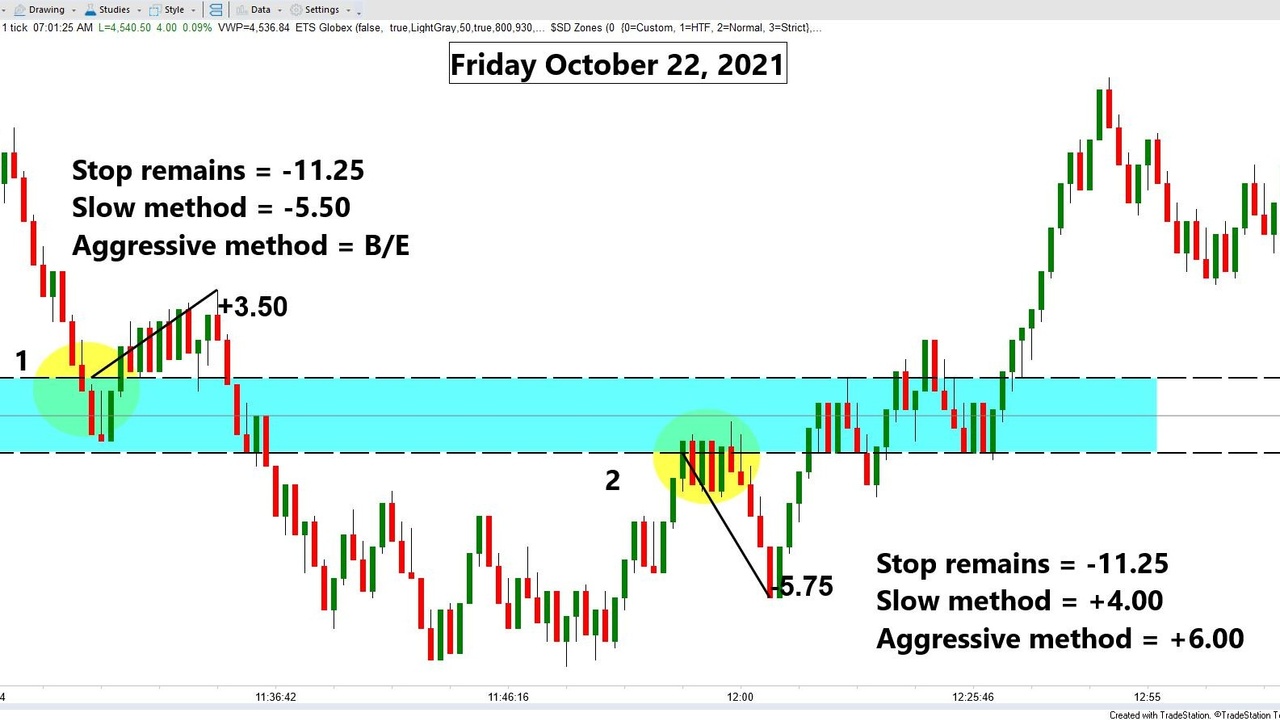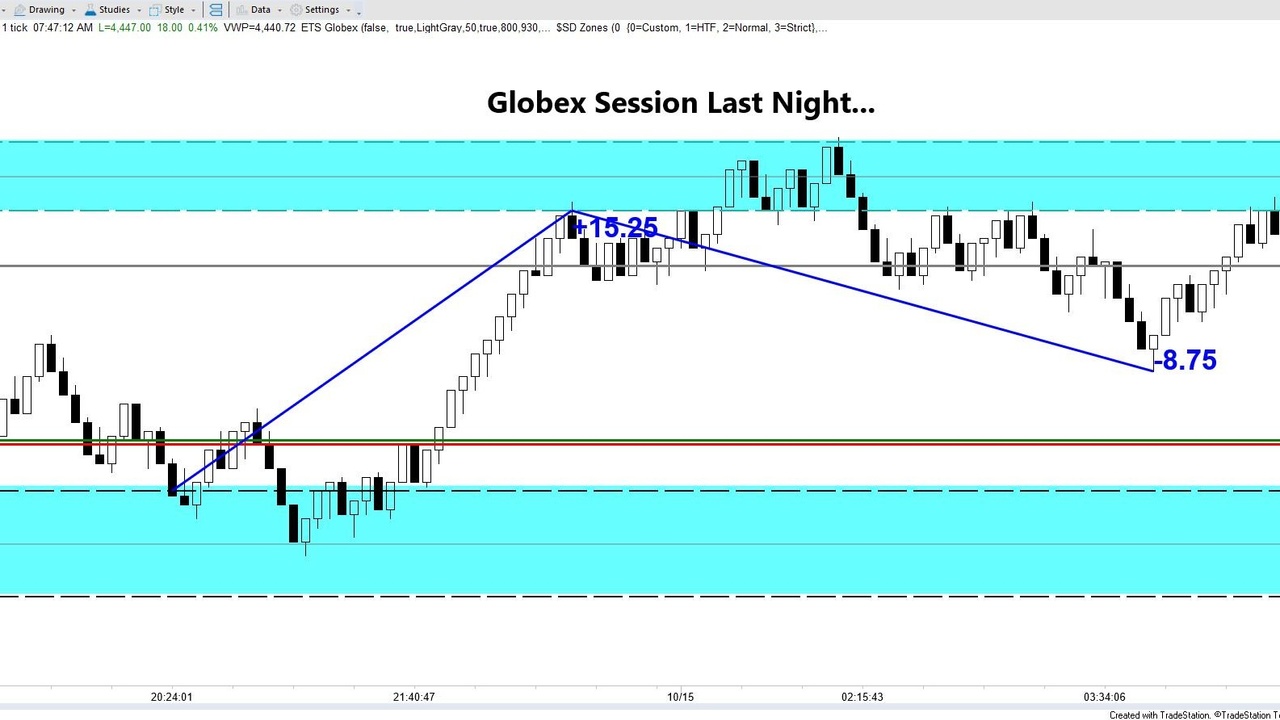The Daily Market Forecast

Today’s Lesson: The Power of Review
Join me on Saturday morning @ 10:00 ET to watch as we review every trade taken in our trading room this week… S&P, Gold & Oil futures. Winners, losers, break-evens, all will be analyzed.
You can meet some of the team and get your questions answered. Click here to reserve your seat.
For Thu 211028 (Plenty can change by the open, be aware.)
Globex Review: No trades triggered yet in a narrow range-bound market.
Day Session Analysis: Sentiment is mixed leaning bearish. Stats are mixed. Jobless Claims & GDP will determine the early trend. Willing to trade either direction under Alt1 stop movement UNLESS/UNTIL the Globex range increases plenty OR the expected move of the SPXW is wide. Thursday (both sessions combined) garnered ONLY 4% of all the gains over the past 5 years in dollars. Breakouts (95%) crush Reversals (5%). Consider not trading Volume Profile. Trading ES/CL/GC using Vol Rev with filters (download the new Edge). Looking to establish a cr...
The Daily Market Forecast... Lesson Day

Today’s Lesson: Winning streaks.
Yesterday was the perfect day… 6 trades all winners trading the S&P, Gold and Oil. The buy at 4560.75 for the S&P caught the exact bottom (read the September 24th blog to understand WHY you should always buy ON the proximal line moving your stop IN if need be).
Everyone enjoys winning streaks and no one knows when they’ll end. But they do.
How many wins in a row is likely? What is the probability? There is a simple mathematical formula to help visualize this called Theory of Runs. You only need two data points to determine the odds of the next trade being a winner: Total number of trades (sample size) and historical win percentage.
Before you shake your head when you read what the win percentage is for our strategies you need to know that breakeven trades are counted as “wins” simply because they are not losses. It’s a reframing technique to help your personal trading psychology. The number is around 60% depending on the asset.
Given the 60% win ra...
The Daily Market Forecast... Lesson Day

Today’s Lesson: Move Stop or Not?
Blindly saying “never move your stop” is saying market conditions don’t change, which makes no sense at all.
In our trading room we find that aggressive stop movement is warranted in certain market conditions. Slow stop movement is warranted in other conditions. NOT moving the stop is flat-out WORSE (both mathematically AND psychologically).
Let’s define the difference between “aggressive” and “slow” stop movement. Using our strategy rules the aggressive rules move the stop to breakeven for the trade itself after target 1 is filled, and to breakeven for remaining contracts after target 2 is filled.
Our slow rules move the stop to a trailing pivot after target 2 is filled.
Choice depends on market conditions. A trending market deserves time and patience. Use the slow method. A choppy market requires fast reaction. Use the aggressive method.
Using Friday’s suggested levels (chart above) the difference in the three methods is huge. Trading 3 contrac...
The Daily Market Forecast... Payday Theory
Today’s Lesson: Payday Friday
If you’re like most retail traders you are focused on growing your trading account so you can increase your risk and ultimately your expected reward. Taking a “paycheck” from your trading account seems like taking a step backward.
The trading account is intangible. The figures on the statement don’t mean the same to you as a tangible reward. Psychologically, you NEED to be rewarded for a job well done. Make those wins REAL.
Here’s a simple trick for getting paid, growing your account, and improving your trading skills simultaneously:
- Determine your payday (weekly, bi-weekly, monthly).
- Log your trading account balance at the start.
- On payday calculate your gain/loss in the account.
- Pay yourself a pre-determined percentage of the gain. Take nothing if you lost.
If you’re more interested in growing the account make the percentage small, maybe 10% or 20% of the gain. Even though the actual paycheck may be small, when you spend it on something tangi...
The Daily Market Forecast... Lesson Day

Today’s Lesson: Know your trade probabilities.
One certainty we have in trading is that price will move. Which way and how far are what we must figure out. Guessing doesn’t work. Using probabilities based on a large body of evidence does (at least enough of the time).
You get your probabilities by capturing trade data (lots of it) and analyzing. Most traders will initiate a strategy by back-testing and documenting what happened. The more stats you have for each historical trade the better.
Here are the key statistics you’ll need to know for both long and short entries (strategies are rarely “symmetrical” which means your eventual rules for longs and shorts will be different): win%, average winner, loss%, average loser, maximum adverse move, maximum favorable move, time of day, higher timeframe trend, etc.
You already know to capture and use the win/loss data. A strategy that wins 50% of the time and has a bigger average winner than loser is a great candidate. Any combination of tho...
The Daily Market Forecast... Lesson Day
Today’s Lesson: No FOMO
Seasoned traders spend time on the review process. They compare their results (behavior) to their plan. This is an excellent way to improve incrementally and get more disciplined.
There is a “downside” you’ll need to handle, though. Since you can’t take every good trade every day and night you’ll find in your review process that you MISS LOTS of great trades. It gets worse when you happen to be in a drawdown and you’re seeing the losers on your statement and the winners absent.
How do you feel about that? You may develop Fear Of Missing Out (FOMO). And that will likely lead to overtrading and at the least, loss of confidence.
Here is a simple reframing trick that should set you straight. Instead of focusing on all the winning trades you missed, start counting the losing trades you didn’t take. Aren’t those really “winners”?
For Wed 211020 (Plenty can change by the open, be aware.)
Globex Review: The levels were congested and not worth trading. Nothing good...
The Daily Market Forecast... Lesson Day
Today’s Lesson: Sizing your trade.
Sizing is NOT determined subjectively. If you follow that path your performance will suffer (if you survive at all). The quantity of shares or contracts you trade is determined by 3 things:
- Stop loss amount.
- Size of your trading account.
- Your personal risk tolerance.
Most traders use a fixed percentage risk formula. Very simple math. You agree that you’ll never risk more than a certain small percentage of your trading account on any one trade. A common “maximum” is 2%. Beginners usually start with 0.5% and grow the percentage as you improve.
The main reason this works so well is this: if you’re doing well and growing your account you will be increasing your risk and likely reward, which makes sense. If you’re struggling or in a drawdown you’ll be decreasing your risk, which makes even MORE sense.
Now here’s the rub… you will have losing streaks and that fixed percentage formula can suddenly seem too high for your personal risk tolerance.
T...
The Daily Market Forecast
Today’s Lesson: Watch a video recording.
If you missed our Saturday morning trade review session, LookBack (5), the recording is available here. You’ll not only learn how to document and review your trades but see firsthand the trade-by-trade performance of The Daily Market Forecast trading room from last week. Enjoy!
For Mon 211018 (Plenty can change by the open, be aware.)
Globex Review: Price has been drifting modestly down through congested levels. The early buy failed and the early morning short did as well.
Day Session Analysis: World sentiment is bearish. Stats suggest some dip-buying. Willing to trade either direction for now but mindful that a firm move down is very possible. Monday (both sessions combined) garnered 27% of all the gains over the past 5 years in dollars. Reversals and Breakouts are about even. Trading ES/CL/GC using BB Rev with filters (download the new Edge). Looking for credit spread candidates both ITM and OTM.
S&P 500 Futures CPL: 4460.75/4464. We’re ...
The Daily Market Forecast... Lesson Day

Today’s Lesson: “All in” or “scale in”?
The highest risk moment of any trade is the entry. That’s the only time you can immediately lose money. “Order filled… order filled!” just that quick. As the trade progresses in either direction you have time to adjust your risk if your rules allow. The risk gets smaller every minute from your entry.
Knowing this you would think that scaling in, buying more as price goes in your direction, would be the wise choice. “Dip your toe in” to start, at that highest risk moment, and press your bet as it works in your direction. Makes good sense.
The opposite choice, entering full position size all at once, has more risk but also more flexibility in exiting. For example, if you knew an asset had movement of X points almost 70% of the time from your entry, wouldn’t you want to grab that quick scalp?
Not a good way to make money overall but not bad as a component of your exit rules. Call it a “risk management” profit target. You’re taking a high probabi...
The Daily Market Forecast... Lesson Day
Today’s Lesson: Keep an open mind.
I read an article from Bloomberg the other day: “Five Traders Tell Us How to Survive a World of Disrupted Markets.” There were plenty of differences between them including chosen asset class, style, strategy, all the typical things.
There was one huge commonality, though. They all stressed keeping an open mind. Be willing to change. Markets change. Technologies change. Laws change.
Change is not always easy, though. We can get into a comfort zone and not want to leave. But we must if we’re going to grow our trading skills.
Here’s an example of why it’s so important. Sixteen months ago, I launched The Daily Market Forecast. We started trading the S&P futures using one strategy with a fixed rule set.
We’re fortunate to have many very skilled traders in our room. Everyone is encouraged to share ideas, successes, failures, anything that might help us improve. We call it Team Trading.
Because of that collective “open mind” and “willingness to change”...
